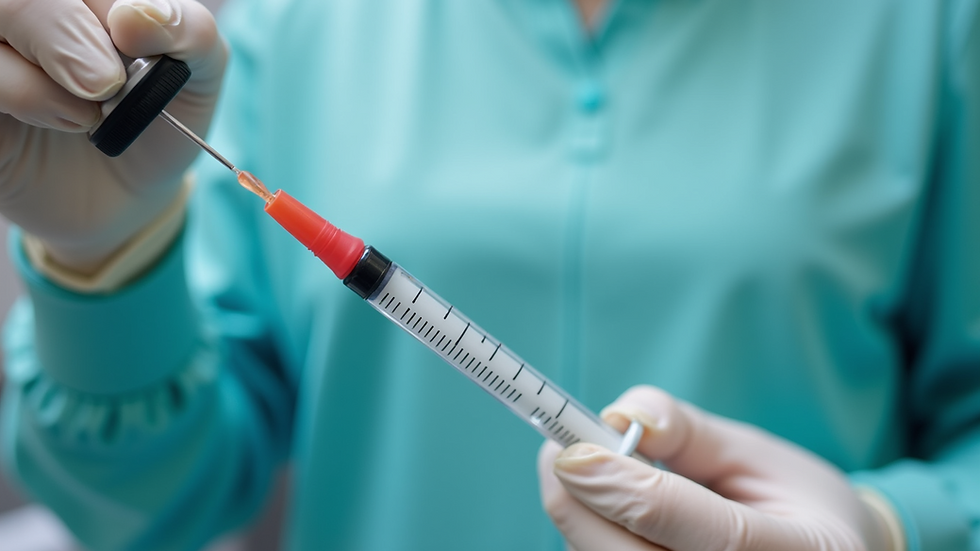Understanding Local Anaesthetic in Dentistry
- enquiries65404
- Nov 3
- 4 min read
When you think about visiting the dentist, what’s the first thing that comes to mind? For many, it’s the fear of pain. But here’s the good news: modern dental anaesthetic techniques have transformed the experience. They help make dental treatments comfortable and pain-free. I want to take you on a gentle journey through the world of local anaesthetic in dentistry. Together, we’ll explore how it works, why it’s safe, and what you can expect during your visit.
What Is Local Anaesthetic and How Does It Work?
Imagine your mouth as a busy city with lots of tiny roads carrying messages to your brain. When you get a dental injection, the local anaesthetic acts like a temporary roadblock. It stops the pain signals from travelling along the nerves to your brain. This means you won’t feel pain during the procedure, even though the dentist is working close by.
Local anaesthetic is usually injected near the area that needs treatment. It numbs the specific spot without affecting your whole body. This targeted approach is why it’s called “local.” The effect usually kicks in within a few minutes and lasts long enough for the dentist to complete the work comfortably.
Here’s a simple breakdown of what happens:
The dentist cleans the area to reduce discomfort.
A tiny needle delivers the anaesthetic near the nerve.
The anaesthetic blocks pain signals.
You feel numbness but no pain.
After the procedure, the numbness fades away naturally.
This process is quick and safe, making it a cornerstone of modern dental care.

Exploring Different Dental Anaesthetic Techniques
Not all dental anaesthetic techniques are the same. Depending on the treatment and your comfort, dentists use various methods to ensure you feel relaxed and pain-free. Let’s look at some common techniques:
1. Infiltration Anaesthesia
This is the most common method. The anaesthetic is injected directly into the tissue near the tooth. It’s perfect for treating upper teeth because the bone there is more porous, allowing the anaesthetic to spread easily.
2. Nerve Block Anaesthesia
For lower teeth, dentists often use nerve blocks. Instead of injecting near the tooth, the anaesthetic is placed near a larger nerve that supplies sensation to a wider area. This technique numbs a bigger region, including several teeth and surrounding tissues.
3. Topical Anaesthesia
Before injections, dentists sometimes apply a gel or spray to numb the surface of your gums. This helps reduce the sting of the needle and makes the experience more comfortable.
4. Intraligamentary Injection
This technique involves injecting anaesthetic directly into the ligament around a tooth. It’s useful for specific cases where other methods might not be ideal.
Each technique is chosen carefully to match the treatment and your needs. The goal is always to keep you comfortable and relaxed.

Why Is Local Anaesthetic Dentistry So Important?
You might wonder, why go through all this fuss with anaesthetic? The answer is simple: it transforms dental care from a source of anxiety into a manageable, even pleasant experience.
Pain is a natural warning system, but in dentistry, it can get in the way of healing and treatment. Without anaesthetic, even routine procedures like fillings or cleanings could be painful. This might make people avoid the dentist altogether, leading to worse problems down the line.
By using local anaesthetic dentistry, dentists can:
Perform treatments efficiently without causing pain.
Help patients feel calm and less anxious.
Allow for more complex procedures to be done safely.
Promote better oral health by encouraging regular visits.
Think of local anaesthetic as a gentle shield that protects you from discomfort, allowing the dentist to work their magic.
What to Expect During Your Anaesthetic Experience
If you’ve never had local anaesthetic before, it’s natural to feel curious or even a bit nervous. Here’s what you can expect during your visit:
Preparation: The dentist will explain the procedure and answer any questions. They might apply a topical anaesthetic to numb the surface.
Injection: You’ll feel a small pinch or pressure as the anaesthetic is injected. It’s quick and usually less uncomfortable than you imagine.
Numbness: Within minutes, the area will feel numb. You might notice a tingling or heavy sensation.
Treatment: The dentist will carry out the procedure while you remain comfortable.
Aftercare: Once the treatment is done, the numbness will wear off in a few hours. Avoid chewing on the numb side to prevent accidental bites.
If you ever feel uneasy, don’t hesitate to tell your dentist. They are there to make sure you feel safe and cared for.
Tips for a Comfortable Dental Visit
To make your dental visit as smooth as possible, here are some friendly tips:
Communicate openly: Let your dentist know if you’re anxious or have had bad experiences before.
Follow instructions: If your dentist gives you pre-appointment advice, like eating or drinking guidelines, follow them.
Relax your body: Take deep breaths and try to stay calm. Listening to music or bringing headphones can help.
Ask about sedation: If you’re very nervous, ask if sedation options are available alongside local anaesthetic.
Plan your day: Schedule your appointment at a time when you’re least rushed or stressed.
Remember, your comfort is a priority. The right dental team will work with you to create a positive experience.
Embracing Modern Dental Care with Confidence
At Eastgate Dental, the focus is on combining trusted traditions with modern techniques. Using the latest dental anaesthetic techniques, they ensure every patient feels relaxed and cared for. Whether it’s a simple check-up or a more involved treatment, the goal is to make your visit as comfortable as possible.
If you’re curious to learn more about how local anaesthetic dentistry can help you, don’t hesitate to reach out. Understanding these techniques can turn your dental visits into a journey of care and confidence.
Your smile deserves the best, and with the right anaesthetic approach, pain-free dental care is within reach. So next time you think about the dentist, imagine a gentle, caring experience where your comfort comes first.
Thank you for joining me on this exploration of dental anaesthetic techniques. I hope it helps you feel more at ease and informed about your dental care options. Here’s to happy, healthy smiles!




Comments